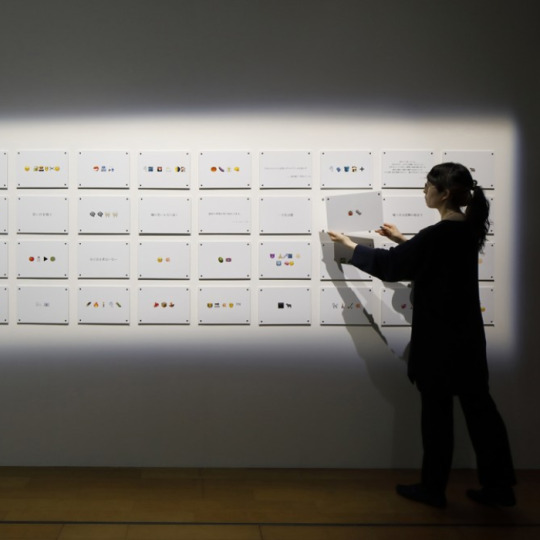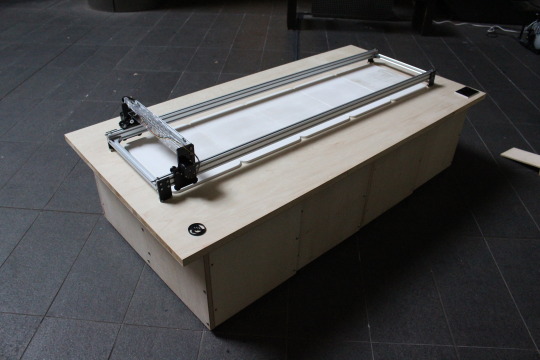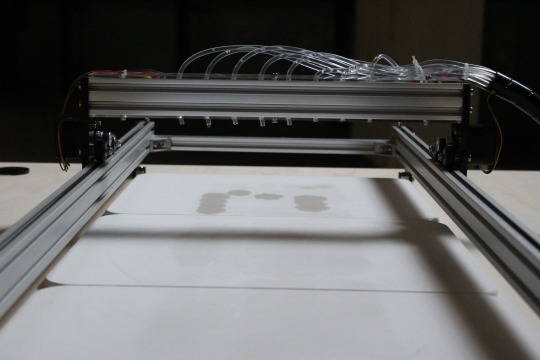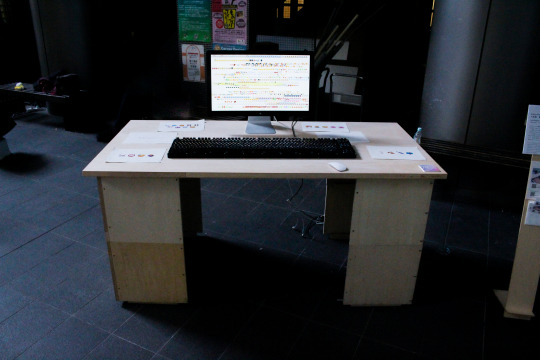#interactive_media_art
Explore tagged Tumblr posts
Text

emolingual (2020-2022)
大原嶺,青田香菜子,藤井樹里 Ryo Ohara, Kanako Aota, and Juri Fujii
About
emolingual(エモリンガル)とは「emoji(絵文字)言語を運用することができる状態」を指す造語で,絵文字にまつわる創作活動や開発を行なうプロジェクト,またそのチームの名称でもあります.
2010年に文字規格の国際基準であるUnicodeに採択されたことをきっかけに,絵文字は現在では「emoji」として世界中の人に使われています.絵文字の人気がUnicodeそのものの普及にも大きく寄与したという説もあるほどで,2021年現在では実に約3,600種類の絵文字がUnicodeに登録されています.優れた視覚的表現力と普遍性からコンパクトに情報を伝えられる一方で,その解釈には地域性やそこに根差した文化的背景が反映される部分も大きく,絵文字による表現の可能性は,その揺らぎ自体をプラスに変換しながら今後も拡大していくことが予想されます.一方で,膨大な選択肢の中から最適な絵文字を直感的に選択することが難しいなど,絵文字普及にあたっては技術的課題もま��多く残されているといえます.emolingualは,インタフェースの開発やグッズの提案に至るまで,絵文字に対する多様なアプローチを通して,言語としてのemojiのさらなる可能性を探究しています.
本展示では,プロジェクトの取り組みのなかから,440種類の絵文字を入力できる専用キーボード《emolingual keyboard》のほか,文脈に合致した絵文字を自動で推定し挿入する入力インタフェースの利用例として,慣用句や文学作品などの一般によく知られたテキスト40個を絵文字翻訳したもの,ウィキペディア日本語版に掲載されたテキストに対して自動で絵文字が挿入されていくプログラムの三つを紹介します.
制作協力:武井祥平
Emolingual is a coined term that refers to the ability to use emoji as a language. It also serves as the name of a project and creative team engaged in various activities and developments related to emoji-based expression.
Since emoji were adopted into the Unicode Standard in 2010, they have become widely used across the globe under the name “emoji.” Some argue that the popularity of emoji significantly contributed to the global spread of Unicode itself. As of 2021, approximately 3,600 emoji have been officially registered in the Unicode Standard. With their rich visual expressiveness and universal design, emoji can convey information compactly. At the same time, their interpretation often reflects cultural contexts and regional variations, making the ambiguity of emoji an asset rather than a limitation. As such, the expressive potential of emoji is expected to continue expanding. On the other hand, challenges remain in the intuitive selection of suitable emoji from a vast set of options, which presents ongoing technical issues for broader adoption.
Through diverse approaches such as interface development and product design, the Emolingual project explores the potential of emoji as a language system.
This exhibition presents three works from the project: the Emolingual Keyboard, a dedicated input device that supports 440 emoji; a set of 40 emoji translations of common idioms and literary texts as examples of an interface that automatically suggests contextually appropriate emoji; and a program that dynamically inserts emoji into content from the Japanese-language edition of Wikipedia.
Collaborator: Shohei Takei
Publication
大原嶺,青田香菜子,藤井樹里.楽しい Emoji 体験のための直感的な Emoji 入力インタフェースの提案, 第58回 情報処理学会エンタテインメン��コンピューティング研究会, 2020年12月
大原嶺,青田香菜子,藤井樹里.文脈に基づいた emoji 推薦とその選択インタフェースの開発, 第27回 未踏IT人材発掘・育成事業 成果報告会, 2021年2月
大原嶺,青田香菜子,藤井樹里.emolingual,オープン・スペース 2021 ニュー・フラットランド,NTTインターコミュニケーション・センター[ICC],2021年10月 – 2022年2月
0 notes
Text

transient record (2019)
藤井樹里,藤波秀麿,大原嶺 Juri Fujii, Hidemaro Fujinami, and Ryo Ohara
About
transient recordは、文字や絵を一時的に記録することができるマシンです。 このマシンは、バーを移動させながら、水滴パターンでその時世間で流れている情報を書き出します。 その情報は、一時的に刻まれ、時間の経過とともに滲み、薄れ、やがて消えていきます。 情報過多の時代において、一時的に話題になり、すぐに廃れていく文字や絵が多く見受けられます。そんな情報を一時的に表出させ、消えていく様を描くことで、世界に放たれる情報のはじまりとおわりを描き出すことを目指します。
Transient record records characters and pictures temporarily. This machine writes the information that is flowing in the world by drawing water droplets. The information fades with time and then disappears. In an era of information overload, there are many characters and pictures that are temporarily talked about and are quickly discarded. We aim to draw out the beginning and the end of the information, released to the world by visualising such information temporarity and drawing it as it disappears.


Publication
藤井樹里,藤波秀麿,大原嶺.transient record,第21回東京大学制作展,東京大学本郷キャンパス,2019年11月
0 notes
Text

emolingual keyboard (2019)
大原嶺,青田香菜子,藤井樹里,角田賢太朗 Ryo Ohara, Kanako Aota, Juri Fujii, and Kentaro Sumida
About
文字コードの国際基準にも取り入れられたEmojiは、いまや世界中の言語と共に用いられるようになりました。 この作品では、SNS上に存在するテクストを集積し、解析を行うことで、様々な文章とEmojiとの対応付けを学習しています。 そして学習モデルを多様な文に適用することで、Emojiが文意の抽象表現として果たす役割を見出します。 また、独自に実装した入力デバイスを用いて言語とEmojiの関係性を探り、表意文字としてのEmojiの可能性を提起します。
Emoji characters were approved by the Unicode Consortium, an organization to maintain multilingual character encoding schemes, and have thus been used by many languages. In this work, we developed a machine learning system mapping various sentences to Emoji characters. This will lead to a realization to the role of Emoji representing an abstract concept in a sentence. Furthermore, we design an original input device to type Emoji characters, and thereby you can find the possibility of Emoji as an ideogram.



Publication
大原嶺,青田香菜子,藤井樹里,角田賢太朗.emolingual,第21回東京大学制作展,東京大学本郷キャンパス,2019年11月
大原嶺,青田香菜子,藤井樹里.emolingual,アジアデジタルアート大賞展FUKUOKA 2019・2020合同受賞作品展,福岡市科学館・福岡市美術館,2021年2月
Awards
学生/インタラクティブ部門 大賞、アジアデジタルアート大賞展FUKUOKA Grand Prize (Student / Interactive Art Division), Asia Digital Art Award FUKUOKA
0 notes
Text

moving arrow (2019)
藤井樹里,大原嶺,中野太輔,藤波秀麿 Juri Fujii, Ryo Ohara, Taisuke Nakano, and Hidemaro Fujinami
About
moving arrowは、オープンソースハードウェアのSteet Writer をベースにした展示ナビゲーションマシンです。このマシンは移動しながら、水滴のパターンで地面に文字や記号を描き、来場者を会場へと導きます。その情報は、案内の痕跡としてその場所に一時的に刻まれ、時間の経過と共に滲み、薄れ、やがて消えていきます。
moving arrow arrows guides people with signs and letters drawn in water. It is drawn by injecting water droplets from 8 valves. The water signs fades with time and then disappears. By using water as one medium, it creates an expression that involves ephemeral.



Publication
藤井樹里,大原嶺,中野太輔,藤波秀麿.moving arrow,第21回東京大学制作展EXTRA,東京大学本郷キャンパス,2019年7月
0 notes